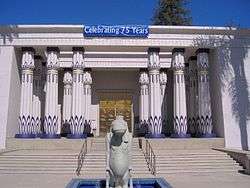Rosicrucian Egyptian Museum
The Rosicrucian Egyptian Museum (REM) is a theosophical museum devoted to Ancient Egypt, located at the Rosicrucian Park in the Rose Garden neighborhood of San Jose, California, United States. It was founded by the Ancient Mystical Order Rosae Crucis. The Rosicrucian Order continues to support and expand the museum and its educational and scientific activities.
History
The founder of AMORC, Dr. Harvey Spencer Lewis (Ph.D., F.R.C.), was a collector of various artifacts with mystical symbolism, some of them from the East. His very first artifact was a small Sekhmet statue. In 1921 he contributed financially to the archaeological excavations at Tel el Amarna (Akhetaten, the capital city of the 18th dynasty pharaoh Akhenaten) of the Egypt Explorations Society of Boston by receiving donations from AMORC members. In return, the Egypt Explorations Society donated several Egyptian antiquities to AMORC.
In 1928, he presented to the public a collection named "The Rosicrucian Egyptian Oriental Museum", located at the administration buildings of AMORC at San Jose, California.
After Lewis' tour in Egypt in 1929, AMORC received many more artifacts and donations and as a result the collection grew significantly, with more than 2000 exhibits.
The second Imperator of AMORC, Ralph Maxwell Lewis (F.R.C.), son of H. Spencer Lewis, decided to build new buildings for the museum. The new museum buildings opened in November 1966.
By that time the museum managed to become unique by:
- Having the largest exhibition of Ancient Egyptian antiquities in the Western US.[1]
- Being the only such museum in the world with buildings constructed in Ancient Egyptian architectural style.
- Having a purpose-built planetarium adjacent to the museum. The Planetarium was the 5th opened in the United States, and the first with a Star Projector built in the country, constructed by H. Spencer Lewis.
- Having its buildings set in an Egyptian revival park.
In 1995, Julie Scott, M.A., S.R.C., moved to San Jose and became Director of the Rosicrucian Egyptian Museum.
- Rosicrucian Museum grounds
 Rosicrucian Museum grounds
Rosicrucian Museum grounds Rosicrucian Museum grounds
Rosicrucian Museum grounds Rosicrucian Museum sign
Rosicrucian Museum sign
Notable exhibits
A notable activity took place in 1999 when the Rosicrucian Egyptian Museum started the traveling exhibition "Women of the Nile" accompanied by many lectures. "Women of the Nile" travelled across the United States of America and Canada, and continued until 2001. In 2000–2002, a stone figure of Cleopatra VII from the collection was displayed in Rome, London, and Chicago in similar exhibitions.
The Rosicrucian Egyptian Museum's child mummy traveled to Stanford University in nearby Palo Alto on May 6, 2005 to be studied under CT scans and other high-resolution methods of remote sensing, in a collaboration between the museum, Silicon Graphics, and Stanford University Hospital and the NASA Biocomputational Lab. The results were released at the 75th Anniversary of the Museum on August 6, 2005, with detailed scans, and these were covered by a Time article on the subject. One of the scanning images won the 2006 Science and Engineering Visualization Challenge 2006 co-sponsored by the National Science Foundation and Science.
A statue of Taweret, the Ancient Egyptian hippopotamus-like goddess of pregnant women and childbirth, once stood at the entrance, but has been moved to the side to facilitate renovations to improve accessibility to the handicapped. Since 2004, the Museum has been completely renovated, with the following Gallery themes:
- Afterlife and Rock Cut Tomb
- Daily Life and Other Cultures
- Kingship and Palace
- Temple (Sekhmet) and Akhenaten's Amarna period
- Rotating Exhibits.
 An upper-class Egyptian male, often referred as "Usermontu"
An upper-class Egyptian male, often referred as "Usermontu"- Early 18th dynasty coffin
- Baboon mummy. There is in fact no baboon inside, the mummy is formed around a ceramic jar.
Rock cut tomb replica
The Rosicrucian Egyptian Museum contains a composite replica of an ancient Egyptian rock-cut tomb, based on photos and sketches taken by Rosicrucian expeditions to tombs at Beni Hasan, in order to give the guests the experience of being in such an excavation. Below are photographs of the interior of the replica tomb, largely containing scenes from the Book of the Dead. The dark interior of the tomb replica is evident.
See also
References
- ↑ Black, Annetta. "San Jose, California, Rosicrucian Egyptian Museum". Atlas Obscura. Atlas Obscura. Retrieved October 4, 2014.
External links
| Wikimedia Commons has media related to Rosicrucian Egyptian Museum. |
Coordinates: 37°20′03″N 121°55′24″W / 37.3342°N 121.9233°W







